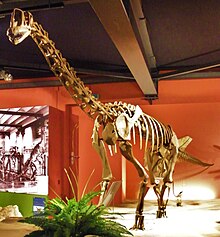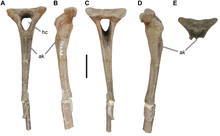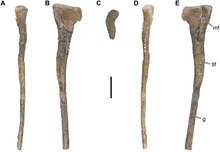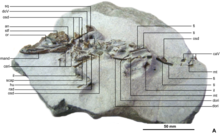Photos • Location

Map of the Lower Saxon Hills with Süntel center-right
| Süntel Formation | |
|---|---|
|
Stratigraphic range:
Kimmeridgian ~ | |
 Süntel Formation at Langenberg quarry | |
| Type | Geological formation |
| Sub-units | Sand-Tonkomplex & Unterbank Members |
| Underlies | Gigas-Schichten & Holzen Formation |
| Overlies | Korallenoolith Formation |
| Thickness | Variable, over 60 m (200 ft) at Langenberg Quarry |
| Lithology | |
| Primary | Limestone |
| Other | Sandstone, claystone, marl |
| Location | |
| Coordinates | 52°18′N 8°48′E / 52.3°N 8.8°E |
| Approximate paleocoordinates | 43°24′N 16°54′E / 43.4°N 16.9°E |
| Region | Nordrhein-Westfalen, Niedersachsen |
| Country | |
| Extent | Lower Saxony Basin |
| Type section | |
| Named for | Süntel |
| Location | Lower Saxon Hills |
| Region | Niedersachsen |
The Süntel Formation, previously known as the Kimmeridge Formation ( German: "Mittlerer Kimmeridge"; Middle Kimmeridge), [1] is a geological formation in Germany. It is Late Jurassic in age, spanning the early to late Kimmeridgian stage. It predominantly consists of limestone deposited in shallow marine carbonate ramp conditions. [2]
Description

The formation is part of the Lower Saxony Basin that borders the Süntel massif of the Lower Saxon Hills, part of the larger Harz Mountains. The formation is described as alternations of glauconitic marl, limestone and sandstone. [3]
Paleontological significance
The formation is known for its fossils, with the Langenberg Quarry having provided fossils of numerous vertebrates.
Dinosaurs
| Dinosaurs of the Süntel Formation | ||||||
|---|---|---|---|---|---|---|
| Genus | Species | Location | Stratigraphic position | Abundance | Notes | Images |
| Europasaurus | E. holgeri | Langenberg Quarry | Bed 83 | Disarticulated remains representing numerous individuals | Sauropod dinosaur |  |
| Allosauroidea [4] | Indeterminate | DfMMh/FV1/19, small pedal ungual, cf. DfMMh/FV/343, small pedal phalanx |  | |||
| cf. Ceratosauria [4] | DfMMh/FV/776, anterior chevron |  | ||||
| cf. Megalosauroidea [4] | DfMMh/FV/287, left fibula |  | ||||
| cf. Tetanurae [4] | DfMMh/FV/105, distal caudal vertebra |  | ||||
| Theropoda [4] | DfMMh/FV2/19, a small pedal phalanx III-1, DfMMh/FV3/19, proximal part of a small right fibula |   | ||||
| Theropoda | Hannover: Lindener Berg, Tönniesberg, and Ahlem, Thüste, Marienhagen, Holzen, Kahlberg and Langenberg Quarry | 18 distinct morphotypes of teeth, referred to " Tyrannosauroidea, as well as Allosauroidea, Megalosauroidea cf. Marshosaurus, Megalosauridae cf. Torvosaurus and probably Ceratosauria" [5] |    | |||
Turtles
| Turtles of the Süntel Formation | ||||||
|---|---|---|---|---|---|---|
| Genus | Species | Location | Stratigraphic position | Abundance | Notes | Images |
| Plesiochelys [4] | Indeterminate | Langenberg Quarry | ||||
| cf. Thalassemys | Indeterminate | DFMMh/FV 296, "skull part (articulated quadrate, squamosal, basisphenoid, and pterygoid), a disarticulated 40 cm long partial carapace, plastron, and one cervical vertebra." [6] | ||||
| Eucryptodira | Indeterminate | Bed 73 | Juvenile carapace with disarticulated skull and right forelimb [7] | |||
Squamates
| Squamates of the Süntel Formation | ||||||
|---|---|---|---|---|---|---|
| Genus | Species | Location | Stratigraphic position | Abundance | Notes | Images |
| Paramacellodidae | Indeterminate | Langenberg Quarry | Partial skeleton [8] | |||
Pterosaurs
| Pterosaurs of the Süntel Formation | ||||||
|---|---|---|---|---|---|---|
| Genus | Species | Location | Stratigraphic position | Abundance | Notes | Images |
| ? Dsungaripteridae | Indeterminate | Langenberg Quarry | DFMMh/FV 500, an articulated partial skeleton consisting of "10 thoracic vertebrae, complete pelvis and sacrum, left and right femur" with an associated possible partial right tibia. [9] |  | ||
Crocodyliformes
| Crocodyliformes of the Süntel Formation | ||||||
|---|---|---|---|---|---|---|
| Genus | Species | Location | Stratigraphic position | Abundance | Notes | Images |
| Knoetschkesuchus [10] | K. langenbergensis | Langenberg Quarry | Bed 83 | two partial skeletons and various isolated bones | Atoposaurid |  |
| Machimosaurus [11] | M. hugii | |||||
| Steneosaurus | S. brevirostris [12] | Rostrum, jaw and postcranial remains | ||||
| Goniopholis [11] | G. simus | |||||
Mammaliaforms
| Mammaliaforms of the Süntel Formation | ||||||
|---|---|---|---|---|---|---|
| Genus | Species | Location | Stratigraphic position | Abundance | Notes | Images |
| Cimbriodon [13] | C. multituberculatus | Langenberg Quarry | Bed 83 | upper and lower p3,p4 and p5 molars | Paulchoffatiid multituberculate | |
| Teutonodon [14] | T. langenbergensis | NLMH 105650, upper right M1 | Pinheirodontid multituberculate [13] | |||
| Storchodon [15] | S. cingulatus | MH 105654, a right upper molar | A large morganucodont | |||
| Hercynodon [16] | H. germanicus | NLMH 105668, left upper molar, NLMH 105669-70 right upper molars, NLMH 105671 left lower molar | Dryolestid | |||
| Paulchoffatiidae [13] | Indeterminate | NLMH 105655, left p4, NLMH 105651; m1 | NLMH 105651 considered an Eobataarid by Martin et al 2016, considered a Paulchoffatiid by Martin et al 2019 | |||
| Docodonta [15] | Indeterminate | |||||
| Dryolestida [15] | Indeterminate | |||||
Ichnofossils
| Ichnofossils of the Süntel Formation | ||||||
|---|---|---|---|---|---|---|
| Genus | Species | Location | Stratigraphic position | Abundance | Notes | Images |
| Megalosauripus [17] | M. teutonicus | Bruns quarry tracksite | Sand-Tonkomplex Member | |||
| Elephantopoides [17] | E. sp. | |||||
| Strömer quarry tracksite | ||||||
| Grallator (Eubrontes) [17] | Grallator (Eubrontes) sp. | |||||
| Iguanodontipus [17] | ?Iguanodontipus sp. | |||||
See also
References
- ^ Lallensack et al., 2015, p.4
- ^ Zuo F, Heimhofer U, Huck S, Luppold FW, Wings O, Erbacher J (January 2018). "Sedimentology and depositional sequences of a Kimmeridgian carbonate ramp system, Lower Saxony Basin, Northern Germany". Facies. 64 (1): 1. doi: 10.1007/s10347-017-0513-0. ISSN 0172-9179. S2CID 134929243.
- ^ Bai et al., 2017
- ^ a b c d e f Evers SW, Wings O (2020-02-06). "Late Jurassic theropod dinosaur bones from the Langenberg Quarry (Lower Saxony, Germany) provide evidence for several theropod lineages in the central European archipelago". PeerJ. 8: e8437. doi: 10.7717/peerj.8437. PMC 7007975. PMID 32071804.
- ^ Gerke, Oliver; Wings, Oliver (2016-07-06). Lötters, Stefan (ed.). "Multivariate and Cladistic Analyses of Isolated Teeth Reveal Sympatry of Theropod Dinosaurs in the Late Jurassic of Northern Germany". PLOS ONE. 11 (7): e0158334. Bibcode: 2016PLoSO..1158334G. doi: 10.1371/journal.pone.0158334. ISSN 1932-6203. PMC 4934775. PMID 27383054.
- ^ Marinheiro J, Mateus O (2011). Occurrence of the marine turtle Thalassemys in the Kimmeridgian of Oker, Germany. 71st Annual Meeting of the Society of Vertebrate Paleontology. p. 151.
- ^ Jansen M, Klein N (July 2014). Angielczyk K (ed.). "A juvenile turtle (Testudines, Eucryptodira) from the Upper Jurassic of Langenberg Quarry, Oker, Northern Germany". Palaeontology. 57 (4): 743–756. doi: 10.1111/pala.12085. S2CID 128991586.
- ^ Richter A, Knötschke N, Kosma R, Sobral G, Wings O (October 2013). "The first Mesozoic lizard from northern Germany (Paramacellodidae, Late Jurassic, Langenberg Quarry) and its taphonomy". Journal of Vertebrate Paleontology (Program and Abstracts): 198.
- ^ Fastnacht M (2005). "The first dsungaripterid pterosaur from the Kimmeridgian of Germany and the biomechanics of pterosaur long bones". Acta Palaeontologica Polonica. 50: 273–288.
- ^ Schwarz D, Raddatz M, Wings O (2017-02-15). Claessens L (ed.). "Knoetschkesuchus langenbergensis gen. nov. sp. nov., a new atoposaurid crocodyliform from the Upper Jurassic Langenberg Quarry (Lower Saxony, northwestern Germany), and its relationships to Theriosuchus". PLOS ONE. 12 (2): e0160617. Bibcode: 2017PLoSO..1260617S. doi: 10.1371/journal.pone.0160617. PMC 5310792. PMID 28199316.
- ^ a b Karl HV, Gröning E, Brauckmann C, Schwarz D, Knötschke N (2006). "The Late Jurassic crocodiles of the Langenberg near Oker, Lower Saxony (Germany), and description of related materials (with remarks on the history of quarrying the "Langenberg Limestone" and "Obernkirchen Sandstone")". Clausthaler Geowissenschaften. 5: 59–77.
- ^ Karl HV, Gröning E, Brauckmann C, Knötschke N (2008). "First remains of the head of Steneosaurus (crocodylomorpha: teleosauridae) from the Late Jurassic of Oker (Lower Saxony, Germany)". Studia Geologica Salmanticensia. 44 (2): 187–201.
- ^ a b c Martin T, Averianov AO, Schultz JA, Schwermann AH, Wings O (2019-08-07). "Late Jurassic multituberculate mammals from Langenberg Quarry (Lower Saxony, Germany) and palaeobiogeography of European Jurassic multituberculates". Historical Biology. 33 (5): 616–629. doi: 10.1080/08912963.2019.1650274. S2CID 201201555.
-
^ Martin TH, Schultz JA, Schwermann AH, Wings OL (2016). "First Jurassic mammals of Germany: Multituberculate teeth from Langenberg Quarry (Lower Saxony)". Palaeontologia Polonica. 67: 171–9.
doi:
10.4202/pp.2016.67_171 (inactive 31 January 2024).
{{ cite journal}}: CS1 maint: DOI inactive as of January 2024 ( link) - ^ a b c Martin T, Averianov AO, Jäger KR, Schwermann AH, Wings O (2019-12-01). "A Large Morganucodontan Mammaliaform from the Late Jurassic of Germany". Fossil Imprint. 75 (3–4): 504–509. doi: 10.2478/if-2019-0030. ISSN 2533-4069. S2CID 210921885.
- ^ Martin, Thomas; Averianov, Alexander O.; Schultz, Julia A.; Schwermann, Achim H.; Wings, Oliver (2021-05-16). "A derived dryolestid mammal indicates possible insular endemism in the Late Jurassic of Germany". The Science of Nature. 108 (3): 23. doi: 10.1007/s00114-021-01719-z. ISSN 1432-1904. PMC 8126546. PMID 33993371.
- ^ a b c d Diedrich, 2011
Bibliography
- Bai, Hua-Qing; Betzler, Christian; Erbacher, Jochen; Reolid, Jesús; Zuo, Fanfan (2017). "Sequence stratigraphy of Upper Jurassic deposits in the North German Basin (Lower Saxony, Süntel Mountains)". Facies. 63 (3). doi: 10.1007/s10347-017-0501-4. S2CID 135060170.
- Lallensack, Jens N.; Sander, P. Martin; Knötschke, Nils; Wings, Oliver (2015). "Dinosaur tracks from the Langenberg Quarry (Late Jurassic, Germany) reconstructed with historical photogrammetry: Evidence for large theropods soon after insular dwarfism" (PDF). Palaeontologia Electronica. 18. Retrieved 2020-09-07.
- Diedrich, C (2011). "Upper Jurassic tidal flat megatracksites of Germany - coastal dinosaur migration highways between European islands, and a review of the dinosaur footprints". Palaeobiodiversity and Palaeoenvironments. 91 (2): 129–155. doi: 10.1007/s12549-010-0044-y. S2CID 140604517.
